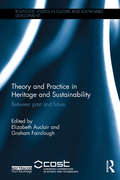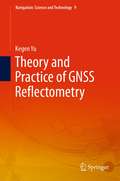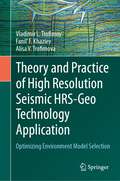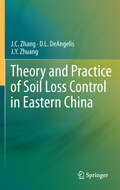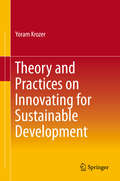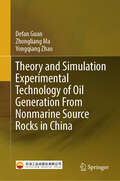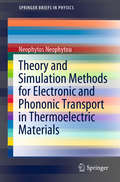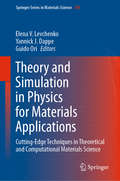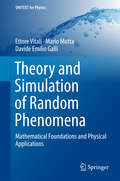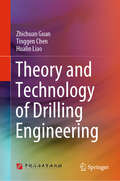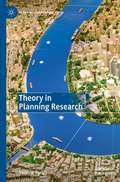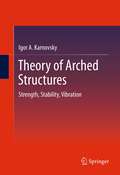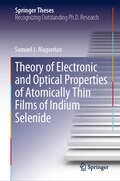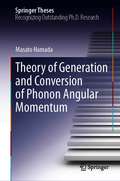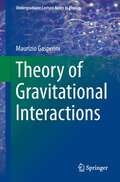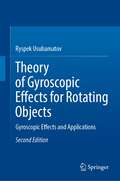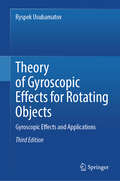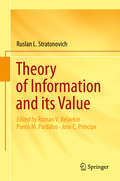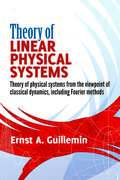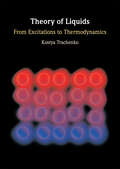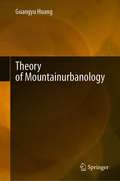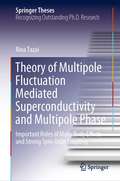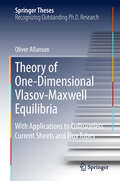- Table View
- List View
Theory and Practice in Heritage and Sustainability: Between past and future (Routledge Studies in Culture and Sustainable Development)
by Elizabeth Auclair and Graham FaircloughThis book explores cultural sustainability and its relationships to heritage from a wide interdisciplinary perspective. By examining the interactions between people and communities in the places where they live it exemplifies the diverse ways in which a people-centred heritage builds identities and supports individual and collective memories. It encourages a view of heritage as a process that contributes through cultural sustainability to human well-being and socially- and culturally-sensitive policy. With theoretically-informed case studies from leading researchers, the book addresses both concepts and practice, in a range of places and contexts including landscape, townscape, museums, industrial sites, every day heritage, ‘ordinary’ places and the local scene, and even UNESCO-designated sites. The contributors, most of whom, like the editors, were members of the COST Action ‘Investigating Cultural Sustainability’, demonstrate in a cohesive way how the cultural values that people attach to place are enmeshed with issues of memory, identity and aspiration and how they therefore stand at the centre of sustainability discourse and practice. The cases are drawn from many parts of Europe, but notably from the Baltic, and central and south-eastern Europe, regions with distinctive recent histories and cultural approaches and heritage discourses that offer less well-known but transferable insights. They all illustrate the contribution that dealing with the inheritance of the past can make to a full cultural engagement with sustainable development. The book provides an introductory framework to guide readers, and a concluding section that draws on the case studies to emphasise their transferability and specificity, and to outline the potential contribution of the examples to future research, practice and policy in cultural sustainability. This is a unique offering for postgraduate students, researchers and professionals interested in heritage management, governance and community participation and cultural sustainability.
Theory and Practice of Dialogical Community Development: International Perspectives
by Peter Westoby Gerard DowlingThis book proposes that community development has been increasingly influenced and co-opted by a modernist, soulless, rational philosophy - reducing it to a shallow technique for ‘solving community problems’. In contrast, this dialogical approach re-maps the ground of community development practice within a frame of ideas such as dialogue, hospitality and depth. For the first time community development practitioners are provided with an accessible understanding of dialogue and its relevance to their practice, exploring the contributions of internationally significant thinkers such as P. Freire, M. Buber, D. Bohm and H.G Gadamer, J. Derrida, G. Esteva and R. Sennett. What makes the book distinctive is that: first, it identifies a dialogical tradition of community development and considers how such a tradition shapes practice within contemporary contexts and concerns – economic, social, political, cultural and ecological. Second, the book contrasts such an approach with technical and instrumental approaches to development that fail to take complex systems seriously. Third, the approach links theory to practice through a combination of storytelling and theory-reflection – ensuring that readers are drawn into a practice-theory that they feel increasingly confident has been 'tried and tested' in the world over the past 25 years.
Theory and Practice of GNSS Reflectometry (Navigation: Science and Technology #9)
by Kegen YuThis is the first authored English book completely focused on global navigation satellite system reflectometry (GNSS-R). It consists of two main parts: the fundamental theory; and major applications, which include ocean altimetry, sea surface wind speed retrieval, snow depth measurement, soil moisture measurement, tsunami detection and sea ice detection. Striking a healthy balance between theory and practice, and featuring in-depth studies and extensive experimental results, the book introduces beginners to the fundamentals, while preparing experienced researchers to pursue advanced investigations and applications in GNSS-R.
Theory and Practice of High Resolution Seismic HRS-Geo Technology Application: Optimizing Environment Model Selection
by Vladimir L. Trofimov Alisa V. Trofimova Fanil' F. KhazievThis book outlines the scientific, methodological and practical foundations for applying High Resolution Seismic HRS-Geo Technology in order to build detailed 2D and 3D seismic acoustic models in the form of acoustic impedances (AI) and reflection coefficients (RC) and the most important geological indicators. The monograph is a continuation of the book by the same authors "Oil and Gas Reservoir Prospecting and Exploration: High-Resolution Seismic HRS techniques and technology".Particular attention is paid to improving the process of searching for AI and RC models using the vector of objective functions, in which various types of residuals between real and model data are iteratively calculated. The well-known criteria for predicting the oil and gas potential of productive deposits from the standpoint of the system analysis principles and the set of geological indicators found from the HRS data are analyzed. The features of solving the main seismogeological problems using HRS-Geo Technology modules are shown, illustrated by numerous examples, and using a special (optimal) processing graph and a set of additional seismic record regularization procedures that provide maximum detail of high-resolution seismic data. The book is meant for scientists and specialists involved in in-depth complex geological interpretation of seismic data in the search and exploration of oil and gas deposits, as well as students of geophysical and geological specialties, graduate students of these specializations and developers.
Theory and Practice of Soil Loss Control in Eastern China
by J. C. Zhang J. Y. Zhuang D. L. DeangelisAfter the 1998 flood of the Yangtze River, one of the world's most important rivers, environmental experts realized that, to control flooding, much more attention must be paid to vegetation cover on bare lands, thin forest land, and shrub-covered land in mountain areas. In 1999, an environmental monitoring project of the forests in 11 provinces of the Yangtze River basin was undertaken. This book reports on soil loss prediction and the successful practices of soil loss control in eastern China in recent years.
Theory and Practices on Innovating for Sustainable Development
by Yoram KrozerThis book explains how income growth and better environmental qualities go hand in hand, and reviews the drivers and barriers to sustainable innovation on the basis of real-life cases. It discusses why innovation-based income growth reduces environmental impacts and how the huge global markets for sustainable innovation are currently hampered by protectionist policies. Subsequently, diverse sustainable innovators are presented in ascending order of the complexity of interactions between innovators and stakeholders. In this context, innovating consumers who create communities of peers in solar powered mobility are examined in the first case. It also focuses on regional tacit inventors, who spur innovation in tourism mobility thanks to the informal policies but whose efforts are obstructed by the formalities of the European Union. Artists with an interest in both innovations and the environment develop art services that deliver experiences of environmental qualities. Though these experiences have gone unrecognised so far, they are nonetheless socially beneficial. The book also shows how technology suppliers develop four different patterns of sanitation, each with its own pros and cons for the specific community's needs and conditions. It discusses how project developers also make innovations in office systems, including socially beneficial ones that do away with the need to commute. It includes an analysis of interactions between consumers pursuing ethical consumption and international trailblazers in corporate responsibility and concludes that it is more rewarding to support social entrepreneurs than to attempt to moralise consumers. Further analysis of interactions between sustainable investors and innovators reveals different groups' opinions about policies and markets, helping to explains their weak influence on policies. Mushrooming local energy initiatives are now evolving into energy service companies, producing shifts on energy markets. Why these innovators emerge and how certain policies are blocking them are explained. The policies of the United States and European Union are compared with regard to the main barriers to and drivers of, the renewable energy business. Though the US invests more money and takes more risks, it is less cost-effective in terms of the number of enterprises and jobs, thanks to the feed-in tariffs in Europe. Lastly, the book also discusses policies that invest in education, skills, knowledge and know-how exchange, but instead abolish perverse? subventions of vested interests to? create conditions for sustainable development.
Theory and Simulation Experimental Technology of Oil Generation From Nonmarine Source Rocks in China
by Yongqiang Zhao Defan Guan Zhongliang MaGuided by organic geochemical methodologies, this book conducts a comparative analysis of the characteristics of oil source rocks deposited across various geological eras within typical continental oil-bearing basins, revisits several issues concerning the oil generation theory of continental oil source rocks, and reshapes organic geochemical thinking methods and simulation experimental techniques, challenging the traditionally dominant "artificial petroleum" theory and experimental techniques. The book is divided into three parts: "Introduction," "Characteristics of Oil Source Rocks in Typical Continental Oil-Bearing Basins in China," and "Simulation Experiments on Oil Generation of Continental Oil Source Rocks," encompassing a total of 12 chapters and 143 figures. It delves into the petroleum geological evolution during the stages of continuous subsidence, overall uplift and denudation, and full shrinkage in major basins such as the Junggar, Ordos, Sichuan, Songliao, and Bohai Bay. The book analyzes the characteristics of the main oil source rocks, develops an oil generation simulation instrument for continental oil source rocks, establishes the experimental technology for low-temperature catalytic cracking of source rocks to simulate oil generation, and reveals the oil generation mechanism of the "geological molecular sieve" and favorable conditions for oil generation in source rocks. It offers new ideas and methods for the evaluation of petroleum resources in continental oil-bearing basins and can be a reference for researchers engaged in petroleum geological and geochemical research, as well as teachers and students working in related fields.
Theory and Simulation Methods for Electronic and Phononic Transport in Thermoelectric Materials (SpringerBriefs in Physics)
by Neophytos NeophytouThis book introduces readers to state-of-the-art theoretical and simulation techniques for determining transport in complex band structure materials and nanostructured-geometry materials, linking the techniques developed by the electronic transport community to the materials science community. Starting from the semi-classical Boltzmann Transport Equation method for complex band structure materials, then moving on to Monte Carlo and fully quantum mechanical models for nanostructured materials, the book addresses the theory and computational complexities of each method, as well as their advantages and capabilities. Presented in language that is accessible to junior computational scientists, while including enough detail and depth with regards to numerical implementation to tackle modern research problems, it offers a valuable resource for computational scientists and postgraduate researchers whose work involves the theory and simulation of electro-thermal transport in advanced materials.
Theory and Simulation in Physics for Materials Applications: Cutting-Edge Techniques in Theoretical and Computational Materials Science (Springer Series in Materials Science #296)
by Elena V. Levchenko Yannick J. Dappe Guido OriThis book provides a unique and comprehensive overview of the latest advances, challenges and accomplishments in the rapidly growing field of theoretical and computational materials science. Today, an increasing number of industrial communities rely more and more on advanced atomic-scale methods to obtain reliable predictions of materials properties, complement qualitative experimental analyses and circumvent experimental difficulties. The book examines some of the latest and most advanced simulation techniques currently available, as well as up-to-date theoretical approaches adopted by a selected panel of twelve international research teams. It covers a wide range of novel and advanced materials, exploring their structural, elastic, optical, mass and electronic transport properties. The cutting-edge techniques presented appeal to physicists, applied mathematicians and engineers interested in advanced simulation methods in materials science. The book can also be used as additional literature for undergraduate and postgraduate students with majors in physics, chemistry, applied mathematics and engineering.
Theory and Simulation of Random Phenomena: Mathematical Foundations and Physical Applications (UNITEXT for Physics)
by Ettore Vitali Mario Motta Davide Emilio GalliThe purpose of this book is twofold: first, it sets out to equip the reader with a sound understanding of the foundations of probability theory and stochastic processes, offering step-by-step guidance from basic probability theory to advanced topics, such as stochastic differential equations, which typically are presented in textbooks that require a very strong mathematical background. Second, while leading the reader on this journey, it aims to impart the knowledge needed in order to develop algorithms that simulate realistic physical systems. Connections with several fields of pure and applied physics, from quantum mechanics to econophysics, are provided. Furthermore, the inclusion of fully solved exercises will enable the reader to learn quickly and to explore topics not covered in the main text. The book will appeal especially to graduate students wishing to learn how to simulate physical systems and to deepen their knowledge of the mathematical framework, which has very deep connections with modern quantum field theory.
Theory and Technology of Drilling Engineering
by Zhichuan Guan Tinggen Chen Hualin LiaoThis book presents the theory and technologies of drilling operations. It covers the gamut of formulas and calculations for petroleum engineers that have been compiled over several years. Some of these formulas and calculations have been used for decades, while others help guide engineers through some of the industry’s more recent technological breakthroughs. Comprehensively discussing all aspects of drilling technologies, and providing abundant figures, illustrations and tables, examples and exercises to facilitate the learning process, it is a valuable resource for students, scholars and engineers in the field of petroleum engineering.
Theory in Planning Research (Planning, Environment, Cities)
by Yvonne RydinDoing research is an essential element of almost all programmes in planning studies as well as related areas such as geography and urban studies, from undergraduate, through Masters to doctoral programmes. While most texts on such research emphasise methodologies, this book is unique in addressing how theoretical frameworks and perspectives can inform research activity. Providing both a concise introduction to a wide range of such theories and detailed engagement with cases of planning research, it provides the reader with the insights necessary to conduct theory-informed research. It offers an understanding of how the choice of a theoretical framework has implications for the focus of the research, the precise research questions addressed and the methodologies that will be most effective in answering those questions. Through practical advice and published examples it will support planning researchers in doing stronger, more widely-applicable research, which answers key questions about planning systems and their role within our societies.
Theory of Arched Structures
by Igor A KarnovskyTheory of Arched Structures: Strength, Stability, Vibration presents detailed procedures for analytical analysis of the strength, stability, and vibration of arched structures of different types, using exact analytical methods of classical structural analysis. The material discussed is divided into four parts. Part I covers stress and strain with a particular emphasis on analysis; Part II discusses stability and gives an in-depth analysis of elastic stability of arches and the role that matrix methods play in the stability of the arches; Part III presents a comprehensive tutorial on dynamics and free vibration of arches, and forced vibration of arches; and Part IV offers a section on special topics which contains a unique discussion of plastic analysis of arches and the optimal design of arches..
Theory of Electronic and Optical Properties of Atomically Thin Films of Indium Selenide (Springer Theses)
by Samuel J. MagorrianThis thesis provides the first comprehensive theoretical overview of the electronic and optical properties of two dimensional (2D) Indium Selenide: atomically thin films of InSe ranging from monolayers to few layers in thickness. The thesis shows how the electronic propertes of 2D InSe vary significantly with film thickness, changing from a weakly indirect semiconductor for the monolayer to a direct gap material in the bulk form, with a strong band gap variation with film thickness predicted and recently observed in optical experiments. The proposed theory is based on a specially designed hybrid k.p tight-binding model approach (HkpTB), which uses an intralayer k.p Hamiltonian to describe the InSe monolayer, and tight-binding-like interlayer hopping. Electronic and optical absorption spectra are determined, and a detailed description of subbands of electrons in few-layer films and the influence of spin-orbit coupling is provided. The author shows that the principal optical excitations of InSe films with the thickness from 1 to 15 layers broadly cover the visible spectrum, with the possibility of extending optical functionality into the infrared and THz range using intersubband transitions.
Theory of Fermi-liquids in Metals: A Compact Overview as an Introduction to Theoretical Solid-State Physics (essentials)
by Michael KinzaThis essential offers a compact introduction to the theory of Fermi liquid for physics students in their main studies. It forms the basis for an understanding of theoretical solid state physics and is part of every introductory lecture on this topic. After a brief overview of the Sommerfeld model of metals, the concept of the quasiparticle is introduced. Important calculations characterizing a Fermi liquid are derived in detailed calculations. The essential concludes with an overview of the microscopic theory of Fermi liquids.This Springer essential is a translation of the original German 1st edition essentials, Theorie der Fermiflüssigkeit in Metallen by Michael Kinza, published by Springer Fachmedien Wiesbaden GmbH, part of Springer Nature in 2018. The translation was done with the help of artificial intelligence (machine translation by the service DeepL.com). A subsequent human revision was done primarily in terms of content, so that the book will read stylistically differently from a conventional translation. Springer Nature works continuously to further the development of tools for the production of books and on the related technologies to support the authors.
Theory of Generation and Conversion of Phonon Angular Momentum (Springer Theses)
by Masato HamadaThis book presents a theoretical study of the generation and conversion of phonon angular momentum in crystals.Recently, rotational motions of lattice vibrations, i.e., phonons, in crystals attract considerable attentions. As such, the book theoretically demonstrate generations of phonons with rotational motions, based on model calculations and first-principle calculations. In systems without inversion symmetry, the phonon angular momentum is shown to be caused by the temperature gradient, which is demonstrated in crystals such as wurtzite gallium nitride, tellurium, and selenium using the first-principle calculations. In systems with neither time-reversal nor inversion symmetries, the phonon angular momentum is shown to be generated by an electric field. Secondly, the book presents the microscopic mechanisms developed by the author and his collaborator on how these microscopic rotations of nuclei are coupled with electron spins. These predictions serve as building blocks for spintronics with phonons or mechanical motions.
Theory of Gravitational Interactions
by Maurizio GasperiniThis reference textbook is an up-to-date and self-contained introduction to the theory of gravitational interactions. The first part of the book follows the traditional presentation of general relativity as a geometric theory of the macroscopic gravitational field. A second, advanced part then discusses the deep analogies (and differences) between a geometric theory of gravity and the gauge theories of the other fundamental interactions. This fills a gap which is present in the context of the traditional approach to general relativity, and which usually makes students puzzled about the role of gravity. The necessary notions of differential geometry are reduced to the minimum, leaving more room for those aspects of gravitational physics of current phenomenological and theoretical interest, such as the properties of gravitational waves, the gravitational interactions of spinors, and the supersymmetric generalization of the Einstein equations. Theory of Gravitational Interactions will be of particular value to undergraduate students pursuing a theoretical or astroparticle curriculum. It can also be used by those teaching related subjects, by PhD students and young researchers working in different scientific sectors but wishing to enlarge their spectrum of interests, and, in general, by all scholars interested in the modern aspects and problems of gravitational interaction.
Theory of Gyroscopic Effects for Rotating Objects: Gyroscopic Effects and Applications
by Ryspek UsubamatovThis book highlights an analytical solution for the dynamics of axially rotating objects. It also presents the theory of gyroscopic effects, explaining their physics and using mathematical models of Euler’s form for the motion of movable spinning objects to demonstrate these effects. The major themes and approaches are represented by the spinning disc and the action of the system of interrelated inertial torques generated by the centrifugal and Coriolis forces, as well as the change in the angular momentum. The interrelation of inertial torques is based on the dependency of the angular velocities of the motions of the spinning objects around axes by the principle of mechanical energy conservation. These kinetically interrelated torques constitute the fundamental principles of the mechanical gyroscope theory that can be used for any rotating objects of different designs, like rings, cones, spheres, paraboloids, propellers, etc. Lastly, the mathematical models for the gyroscopic effects are validated by practical tests. The 2nd edition became necessary due to new development and corrections of mathematical expressions: It contains new chapters about the Tippe top inversion and inversion of the spinning object in an orbital flight and the boomerang aerodynamics.
Theory of Gyroscopic Effects for Rotating Objects: Gyroscopic Effects and Applications
by Ryspek UsubamatovThis book highlights an analytical solution for the dynamics of axially rotating objects. It also presents the theory of gyroscopic effects, explaining their physics and using mathematical models of Euler’s form for the motion of movable spinning objects to demonstrate these effects. The major themes and approaches are represented by the spinning disc and the action of the system of interrelated inertial torques generated by the centrifugal and Coriolis forces, as well as the change in the angular momentum. The interrelation of inertial torques is based on the dependency of the angular velocities of the motions of the spinning objects around axes by the principle of mechanical energy conservation. These kinetically interrelated torques constitute the fundamental principles of the mechanical gyroscope theory that can be used for any rotating objects of different designs, like rings, cones, spheres, paraboloids, propellers, etc. Lastly, the mathematical models for the gyroscopic effects are validated by practical tests. This book is highlighted in its already third edition. The new edition comprises many new sections for several chapters or new chapters. The most important ones are: Chapter 3 includes a mathematical model for the section inertia torques acting on the spinning annulus and thin ring. The latter does not have a full solution because the handbooks comprise simplified parameters that cannot be used for an exact solution. Chapter 4 offers mathematical model for the arbitrary disposition of the spinning object in space that shows the action of the additional four inertial torques acting on the third axis and new dependencies of gyroscope motions. Chapter 7 now presents mathematical model for the gyroscope nutation with a full solution. The known mathematical model presents a partial solution due to the complexity of the problem.
Theory of Information and its Value
by Ruslan L. StratonovichThis English version of Ruslan L. Stratonovich’s Theory of Information (1975) builds on theory and provides methods, techniques, and concepts toward utilizing critical applications. Unifying theories of information, optimization, and statistical physics, the value of information theory has gained recognition in data science, machine learning, and artificial intelligence. With the emergence of a data-driven economy, progress in machine learning, artificial intelligence algorithms, and increased computational resources, the need for comprehending information is essential. This book is even more relevant today than when it was first published in 1975. It extends the classic work of R.L. Stratonovich, one of the original developers of the symmetrized version of stochastic calculus and filtering theory, to name just two topics.Each chapter begins with basic, fundamental ideas, supported by clear examples; the material then advances to great detail and depth. The reader is not required to be familiar with the more difficult and specific material. Rather, the treasure trove of examples of stochastic processes and problems makes this book accessible to a wide readership of researchers, postgraduates, and undergraduate students in mathematics, engineering, physics and computer science who are specializing in information theory, data analysis, or machine learning.
Theory of Linear Physical Systems: Theory of physical systems from the viewpoint of classical dynamics, including Fourier methods
by Ernst A. GuilleminAn eminent electrical engineer and authority on linear system theory takes upper-level undergraduates and graduate students beyond the average introductory circuits course, providing them with additional background for understanding advanced network synthesis. This sophisticated treatise broadens students' understanding of the topological and algebraic relations for establishing equilibrium equations and transformations between sets of variables. The text further examines energy functions in both active and passive situations as well as important properties of impedance and similar characterizing functions.The treatment also explores the evaluation and prediction of approximation and truncation errors attendant upon the use of numerical methods of direct and inverse Fourier transform evaluation; the properties of partial sums; and the interpretation of limit processes. In addition, the text stresses the relation between the Fourier and Laplace methods and the approach in classical dynamics, basing the evaluation of Fourier integrals upon meaningful physical reasoning and providing an effective tool for dealing with special problems from the viewpoint of classical dynamics.
Theory of Liquids: From Excitations to Thermodynamics
by Kostya TrachenkoOf the three basic states of matter, liquid is perhaps the most complex. While its flow properties are described by fluid mechanics, its thermodynamic properties are often neglected, and for many years it was widely believed that a general theory of liquid thermodynamics was unattainable. In recent decades that view has been challenged, as new advances have finally enabled us to understand and describe the thermodynamic properties of liquids. This book explains the recent developments in theory, experiment and modelling that have enabled us to understand the behaviour of excitations in liquids and the impact of this behaviour on heat capacity and other basic properties. Presented in plain language with a focus on real liquids and their experimental properties, this book is a useful reference text for researchers and graduate students in condensed matter physics and chemistry as well as for advanced courses covering the theory of liquids.
Theory of Mountainurbanology
by Guangyu HuangThis book is about mountainurbanology grounded in Southwest China, where mountain is a typical landform for many towns and cities. From the multi-disciplinary perspective in a dynamic changing context, it presents a comprehensive framework including the location of mountain city, planning, design, building, transportation, disaster, aesthetics and governance in building up mountain cities based on investigation of natural, social and economic studies. The book also emphasizes ecological planning method based on topography in mountainous area through the lens of teaching and practice on urban planning for over half a century in Southwest China. It is a highly informative book providing academic insight for senior undergraduates, graduate students, lecturers, research professionals and decision makers with an interest in urban planning, ecology, planning and design in mountainous region development. Prof. Guangyu Huang is regarded as Founding Pioneer of mountainurbanology in China, a sub-discipline of urban planning.
Theory of Multipole Fluctuation Mediated Superconductivity and Multipole Phase: Important Roles of Many Body Effects and Strong Spin-Orbit Coupling (Springer Theses)
by Rina TazaiA strong spin-orbit interaction and Coulomb repulsion featuring strongly correlated d- and f-electron systems lead to various exotic phase transition including unconventional superconductivity and magnetic multipole order. However, their microscopic origins are long standing problem since they could not be explained based on conventional Migdal-Eliashberg theorem. The book focuses on many-body correlation effects beyond conventional theory for the d- and f-electron systems, and theoretically demonstrates the correlations to play significant roles in “mode-coupling” among multiple quantum fluctuations, which is called U-VC here. The following key findings are described in-depth: (i) spin triplet superconductivity caused by U-VC, (ii) being more important U-VC in f-electron systems due to magnetic multipole degrees of freedom induced by a spin-orbit interaction, and (iii) s-wave superconductivity stabilized cooperatively by antiferromagnetic fluctuations and electron-phonon interaction contrary to conventional understanding. The book provides meaningful step for revealing essential roles of many-body effects behind long standing problems in strongly correlated materials.
Theory of One-Dimensional Vlasov-Maxwell Equilibria: With Applications To Collisionless Current Sheets And Flux Tubes (Springer Theses)
by Oliver AllansonThis book describes and contextualises collisionless plasma theory, and in particular collisionless plasma equilibria. The Vlasov–Maxwell theory of collisionless plasmas is an increasingly important tool for modern plasma physics research: our ability to sustain plasma in a steady-state, and to mitigate instabilities, determines the success of thermonuclear fusion power plants on Earth; and our understanding of plasma aids in the prediction and mitigation of Space Weather effects on terrestrial environments and satellites. Further afield, magnetic reconnection is a ubiquitous energy release mechanism throughout the Universe, and modern satellites are now able to make in-situ measurements with kinetic scale resolution. To keep pace with these challenges and technological developments, a modern scientific discussion of plasma physics must enhance, and exploit, its ‘literacy’ in kinetic theory. For example, accurate analytical calculations and computer simulations of kinetic instabilities are predicated on a knowledge of Vlasov–Maxwell equilibria as an initial condition. This book highlights new fundamental work on Vlasov–Maxwell equilibria, of potential interest to mathematicians and physicists alike. Possible applications involve two of the most significant magnetic structures known to confine plasma and store energy: current sheets and flux tubes.
